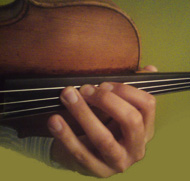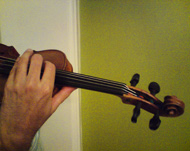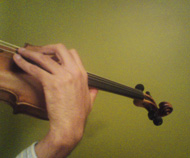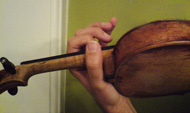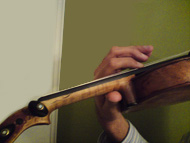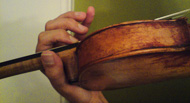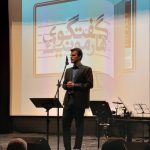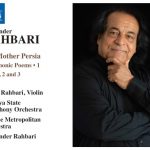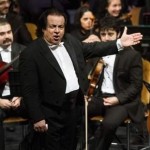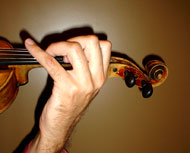
4.3.1. To practice playing of doubles of notes involving two different fingers, each note is played at separate bows with slow tempo, each note is played perfectly regarding its bass and tenor sounds and then the considered double is played at another bow while considering the resulted sound of the double
To increase the dominance of left hand fingers at playing doubles, it is suggested to keep the first finger on the string while playing the second note.
4.1.4. To play a double involving a finger(Quint), player should follow the method mentioned in the paragraph 3.1.3.3 without allowing finger to turn right or left on the fingerboard.
Notification 19: the study of playing continuous doubles which require position changing is according to the general rules of left hand position changing that will be discussed later in this article.
Notification 20: to play doubles, it is necessary to correctly adjust the latitudinal distance of the strings on the nut and the bridge.
Patterns 1/5
Left hand positions
In the different positions of left hand, finger placing should be according to the following essential rules:
5.1.1. at the beginning of doing the practices of positions, in order to acquire a better understanding of the process of finger placing at different positions and to play the notes perfectly, it would be more beneficial to practice Bar by bar the notes playable at the first position, at this position and then practice them at their corresponding position (notes out of the domain of the first position can be also played at bass octaves)
5.1.2. at positions first to forth, as it was mentioned about the point where thumb is placed at first position in the paragraph 1.2.2, thumb is placed at the side of neck, just opposite of the touch point of the first finger on the fingerboard, and it’s better to be in line with it and not before or after it.
5.1.3. At positions fifth and sixth due to the special shape of violin neck, first finger is not in line with thumb and it gradually shifts under the neck.
5.1.4. At position seventh, left thumb is completely under violin neck and after this position elbow moves gradually from its original place under fingerboard toward right. As hand moves to higher positions, elbow moves out more and more and thumb gradually moves out of the underneath of the neck.
5.1.5. The point referred at paragraph 3.2.1.3 about finger placing from left half at first position is true about other positions too. That is, if we assume a line in direction of the finger length, that divides the length into two right and left haves, it’s necessary for the player to touch the fingerboard with the left half of her fingertip.
Pattern 1.6
Changing left hand positions
Changing left hand position on a string due to longitudinal shift of a finger on the fingerboard which results in change throughout the vibrating string and produce different sounds is according to the following rules:
6.1.1. During changing position, from position first to forth, set of thumb and left hand should move harmoniously and simultaneously from elbow; avoid any unharmonious movement of thumb in relation to fingers and hand.
Notification 21.quick increasing glissando of left hand occurring at a short moment and by momentarily passing of hand over several positions, does not follow this rule and thumb always shifts with lower speed and longitudinal movement comparing to hand and other fingers.
In this type of glissando, if the source note is in the first position, from position first to forth thumb shifts thoroughly to underneath of the neck.
In momentary glissando, a part of the distance between two notes in source and destination positions, is passed by opening the interior curve of the finger.
6.1.2. The time spent for usual changing of position over fingerboard is dependent on the optimal tempo in the destination position. The spent time for shifting should not affect the tempo at the destination position, regardless the direction of hand movement; upward or downward.
Finger placing from left half at seventh position
Thorough twisting of thumb to underneath of the neck at seventh position
Momentary glissando and opening of the third finger’s interior curve
Thumb and first finger being in the same direction at the fourth position from another view
Gradual movement of thumb under the neck
Moving the first finger out of the line of thumb at fifth position
